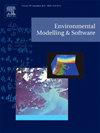将地理信息系统整合到监管分散模型中的 Python 工具包,用于精细化污染建模
IF 4.8
2区 环境科学与生态学
Q1 COMPUTER SCIENCE, INTERDISCIPLINARY APPLICATIONS
引用次数: 0
摘要
AERMOD 被指定为美国环境保护署(EPA)的首选空气扩散模型,用于从 2020 年开始的交通项目热点分析。其建模过程中的关键挑战之一是对道路几何形状进行空间编码,尤其是在模拟具有复杂几何设计的高速公路时。这项研究提出了一个开源 Python 软件包 GTA,它可以将公开可用的道路地理信息系统(GIS)图层转换为定义的排放源,并将 MOtor 车辆排放模拟器(MOVES)输出的基于排放源的排放率转换为 AERMOD 模型。研究选取了亚特兰大的一个郊区,从 PM2.5 年浓度结果以及手动和使用基于建议方法开发的软件为高速公路网络建模准备 AERMOD 输入文件的速度两方面进行了综合分析。结果证明,所提出的方法大大加快了 AERMOD 输入文件的准备过程,并方便了多情景或敏感性分析中多种建模配置的测试。本文章由计算机程序翻译,如有差异,请以英文原文为准。
A Python toolkit for integrating geographic information system into regulatory dispersion models for refined pollution modeling
AERMOD is designated as U.S. Environmental Protection Agency (EPA)'s preferred air dispersion model for refined transportation project hot-spot analyses beginning in 2020. One of the key challenges in its modeling process is spatially encoding roadway geometry, especially when simulating highways with complex geometric designs. This research proposed an open-source Python package, GTA, which enables conversion of publicly available roadway Geographic Information System (GIS) layers into defined sources, and source-based emission rates from MOtor Vehicle Emissions Simulator (MOVES) output for AERMOD modeling. The research selected a suburban area in Atlanta, and conducted a comprehensive analysis in terms of annual PM2.5 concentration results and the speed of preparing AERMOD input files for highway network modeling both manually and using software developed based on the proposed methodology. The results prove that the proposed methodology significantly expedites the AERMOD input preparation process, and facilitates convenient testing of multiple modeling configurations for multi-scenario or sensitivity analysis.
求助全文
通过发布文献求助,成功后即可免费获取论文全文。
去求助
来源期刊

Environmental Modelling & Software
工程技术-工程:环境
CiteScore
9.30
自引率
8.20%
发文量
241
审稿时长
60 days
期刊介绍:
Environmental Modelling & Software publishes contributions, in the form of research articles, reviews and short communications, on recent advances in environmental modelling and/or software. The aim is to improve our capacity to represent, understand, predict or manage the behaviour of environmental systems at all practical scales, and to communicate those improvements to a wide scientific and professional audience.
 求助内容:
求助内容: 应助结果提醒方式:
应助结果提醒方式:


